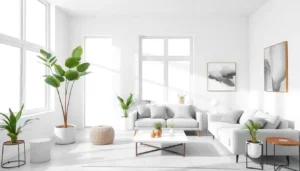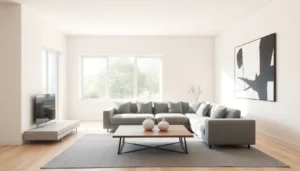Table of Contents
ToggleIn a world bursting with stuff, minimalist space planning is like a breath of fresh air—or a well-organized closet. It’s not just about tossing out the old junk; it’s about creating a serene environment that feels as good as it looks. Imagine living in a space where every item has a purpose and every corner invites calmness. Sounds dreamy, right?
Minimalism isn’t just for hipsters in trendy lofts; it’s for anyone who’s ever tripped over a rogue shoe or lost a remote in the couch abyss. By embracing minimalist space planning, you can transform cluttered chaos into a clean, functional oasis. So grab your measuring tape and get ready to create a space that not only looks good but also makes you feel good. Who knew less could actually be more?
Understanding Minimalist Space Planning
Minimalist space planning transforms areas into serene, organized environments. This approach emphasizes simplicity and functionality, attracting attention from diverse individuals.
Definition and Principles
Minimalist space planning focuses on reducing clutter and prioritizing essential items. Each piece of furniture and decor serves a clear purpose, contributing to an uncluttered aesthetic. Clarity in design remains vital, as a cohesive layout enhances functionality. Open spaces encourage movement and foster a calm atmosphere. Natural materials and neutral colors often create a tranquil environment. Any design choice aligns with the overarching goal of minimalism—achieving balance and harmony in living spaces.
Benefits of Minimalist Space Planning
Minimalist space planning significantly reduces stress and enhances mental clarity. An organized environment simplifies daily tasks, saving time and energy. Reduced belongings lead to improved focus, allowing individuals to concentrate on what truly matters. Flexibility increases when spaces remain uncluttered, accommodating various activities with ease. Minimalism often encourages eco-friendliness through mindful consumption and resource management. Ultimately, individuals enjoy a visually appealing and functional environment that promotes well-being and peace of mind.
Key Elements of Minimalist Space

Minimalist space planning incorporates essential elements that organize and simplify environments effectively. Each component plays a significant role in achieving a serene atmosphere.
Open Spaces and Layouts
Open spaces promote freedom of movement and create a sense of tranquility. Furniture placement centers around functionality, allowing for easy navigation. Arranging pieces to facilitate natural flow enhances the user experience and reduces clutter. Minimalist layouts often feature multifunctional furniture, which supports diverse activities while saving space. Specific zones can be defined using rugs or lighting, maintaining an uncluttered appearance without sacrificing purpose.
Color Palettes and Materials
Color palettes in minimalist spaces typically lean towards neutral shades, which foster calmness and harmony. Whites, beiges, and grays encourage light reflection and create a clean aesthetic. Incorporating natural materials, such as木, stone, and textiles, adds warmth and texture. Each choice emphasizes simplicity while maintaining visual interest. Using fewer colors in decor helps achieve a cohesive look, reinforcing a sense of order. Subtle patterns can add depth without overwhelming the space, ensuring a peaceful environment is cultivated.
Tips for Effective Implementation
Implementing minimalist space planning requires thoughtful strategies. Focus on decluttering and organization first to create an inviting atmosphere.
Decluttering and Organization
Start the decluttering process by assessing each item’s necessity. Keep only those belongings that serve a purpose or bring joy. Use storage solutions like baskets or shelves to maintain order. Establish designated zones for different activities, ensuring that everything has a place. Apply the one-in-one-out rule to avoid accumulating unnecessary items. Tackle one area at a time, breaking down the task into manageable sections. Regularly revisit spaces to prevent clutter from reoccurring. Prioritizing functionality and simplicity leads to a more harmonious environment.
Furniture Selection and Arrangement
Choose furniture that meets specific needs while enhancing comfort. Opt for multifunctional pieces, such as a sofa bed or storage ottoman, to maximize space efficiency. When arranging furniture, create open pathways for easy movement. Position items to foster conversation and maintain visual appeal. Keep larger pieces away from high-traffic areas to avoid obstruction. Select a cohesive color palette to unify the space, using neutral tones for serenity. Consider the scale of furniture in relation to the room size, ensuring balance and proportion are maintained. Thoughtful selection and arrangement solidify the minimalist aesthetic.
Real-Life Examples of Minimalist Space Planning
Exploring real-life examples highlights the effectiveness of minimalist space planning in various environments. The following sections provide insights into residential and commercial applications.
Residential Spaces
Minimalist home designs often feature open layouts that enhance natural light and create a sense of spaciousness. Each piece of furniture serves a distinct purpose, avoiding unnecessary clutter. For instance, a living room might incorporate a sleek sofa and a multifunctional coffee table, creating a welcoming atmosphere without overwhelming the senses. Neutral color palettes dominate, promoting calm and facilitating relaxation. In bedrooms, minimal decor allows for peaceful retreats, with only essential items like a bed and bedside tables. This focused approach maximizes usability while fostering tranquility.
Commercial Spaces
Minimalism within commercial environments can significantly improve productivity and client experiences. Open office spaces commonly utilize clean lines and abundant natural light to create inviting work areas. Desks with integrated storage solutions prevent clutter, ensuring a more organized work surface. Retail spaces often embrace minimal displays, allowing products to shine without distractions. For instance, a minimalist boutique may showcase items on simple shelving, drawing attention to unique designs. Neutral walls paired with subtle textures maintain a cohesive brand image while promoting a serene shopping experience.
Embracing minimalist space planning can significantly enhance both the functionality and aesthetics of any environment. By prioritizing essential items and creating open layouts, individuals can cultivate a serene atmosphere that promotes mental clarity and well-being. The thoughtful arrangement of furniture and the use of natural materials contribute to a cohesive design that feels both inviting and purposeful.
As more people recognize the benefits of minimalism, transforming cluttered spaces into tranquil havens becomes increasingly achievable. This approach not only simplifies daily living but also fosters a deeper connection to one’s surroundings, ultimately leading to a more fulfilling lifestyle. Adopting minimalist principles invites peace and clarity into everyday life, making it a worthwhile endeavor for anyone looking to improve their space.










